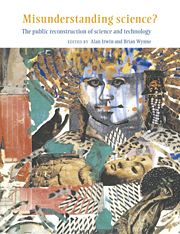Book contents
- Frontmatter
- Contents
- Acknowledgements
- Introduction
- 1 Misunderstood misunderstandings: social identities and public uptake of science
- 2 Science and Hell's kitchen: the local understanding of hazard issues
- 3 Disembodied knowledge? Making sense of medical science
- 4 Now you see it, now you don't: mediating science and managing uncertainty in reproductive medicine
- 5 Ignoring science: discourses of ignorance in the public understanding of science
- 6 Insiders and outsiders: identifying experts on home ground
- 7 Authorising science: public understanding of science in museums
- 8 Nature's advocates: putting science to work in environmental organisations
- 9 Proteins, plants, and currents: rediscovering science in Britain
- Conclusions
- Notes on contributors
- Select bibliography
- Index
7 - Authorising science: public understanding of science in museums
Published online by Cambridge University Press: 16 October 2009
- Frontmatter
- Contents
- Acknowledgements
- Introduction
- 1 Misunderstood misunderstandings: social identities and public uptake of science
- 2 Science and Hell's kitchen: the local understanding of hazard issues
- 3 Disembodied knowledge? Making sense of medical science
- 4 Now you see it, now you don't: mediating science and managing uncertainty in reproductive medicine
- 5 Ignoring science: discourses of ignorance in the public understanding of science
- 6 Insiders and outsiders: identifying experts on home ground
- 7 Authorising science: public understanding of science in museums
- 8 Nature's advocates: putting science to work in environmental organisations
- 9 Proteins, plants, and currents: rediscovering science in Britain
- Conclusions
- Notes on contributors
- Select bibliography
- Index
Summary
Science communicators are widely acknowledged to have an important role to play in the public understanding of science. Despite this acknowledgement, the role is often seen as one of simply transporting information, like so many potatoes on a conveyor belt, from the world of science to the public (the transportation model) or else as a relatively straightforward matter of simplification and translation (the translation model). The aim of this chapter is to show that there is more to the communication of science than this supposedly value-free simplification and packaging; and that science communication involves selection and definition, not just of which ‘facts’ are presented to the public, but of what is to count as science and of what kind of entity or enterprise science is to be. That is, science communicators act as authors of science for the public. They may also, however, by dint of their own institutional status, give implicit stamps of approval or disapproval to particular visions or versions of science. That is, they may act as authors with special authority on science – as authorisers of science.
Museums are one type of institution involved in the communication, authoring, and authorisation of science, and as such they share many of the same problems, and can exemplify many of the same issues, as other science media. Although museums and science centres reach a smaller public than do some other science communicators – such as schools and television – this public is nevertheless substantial. Over the last decade in particular, many museums, and their relatives the science centres, have been involved in developing new science communication strategies, strategies which have increasingly gone under the label of ‘the public understanding of science’.
- Type
- Chapter
- Information
- Misunderstanding Science?The Public Reconstruction of Science and Technology, pp. 152 - 171Publisher: Cambridge University PressPrint publication year: 1996
- 8
- Cited by



